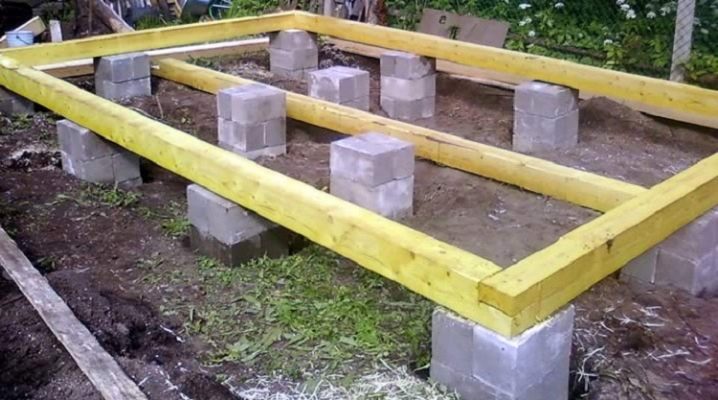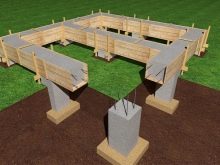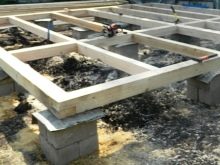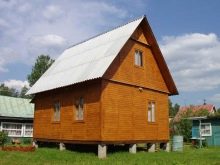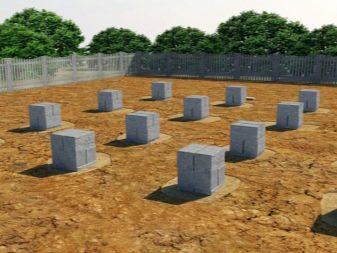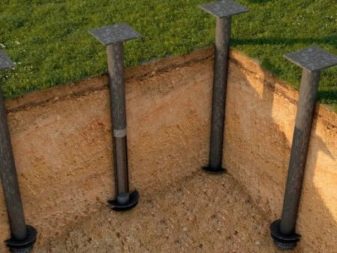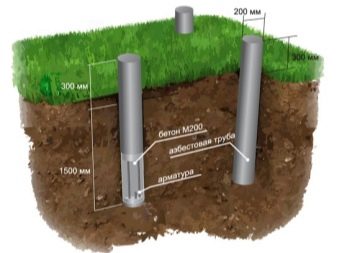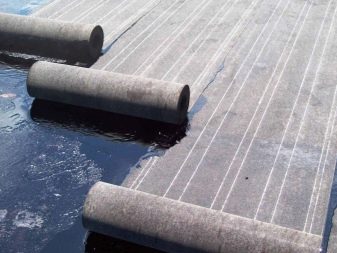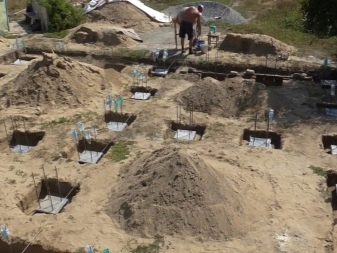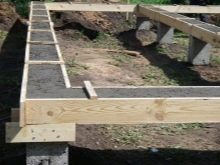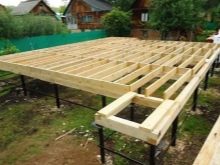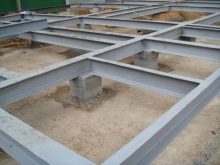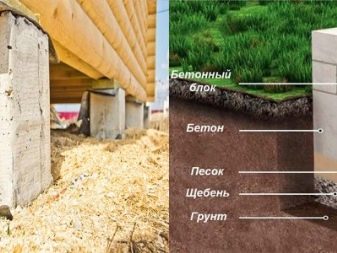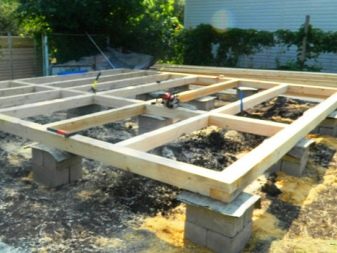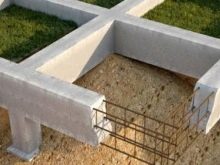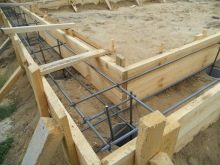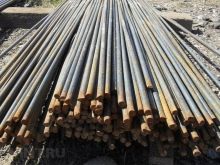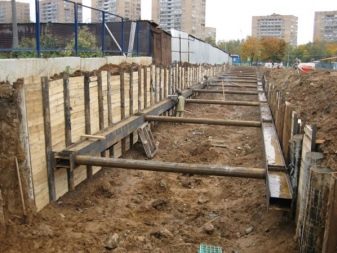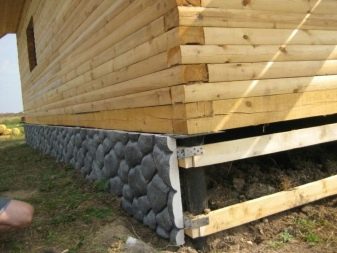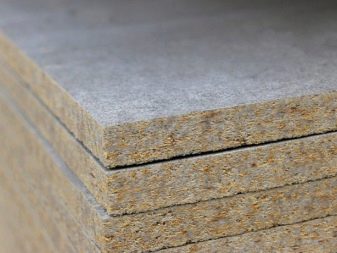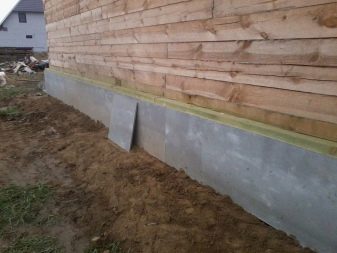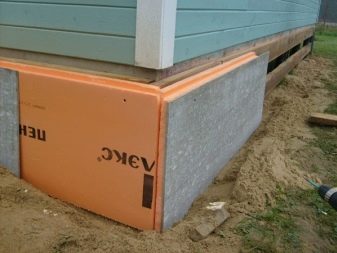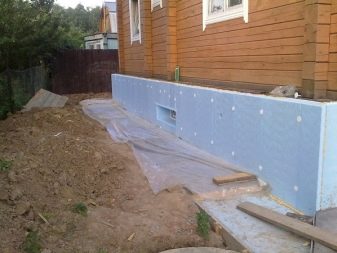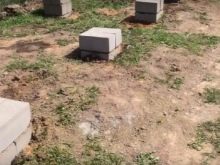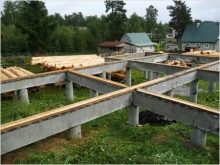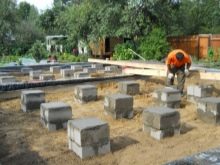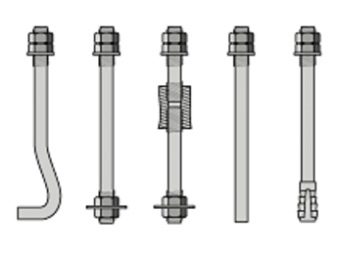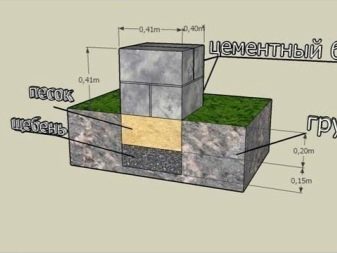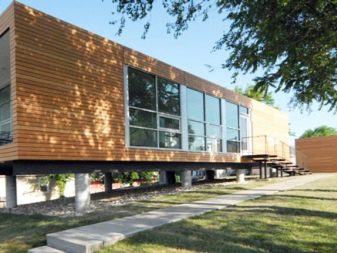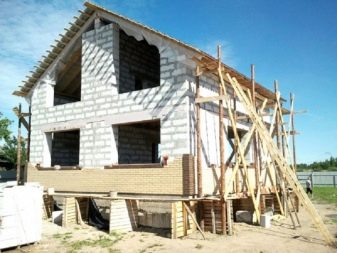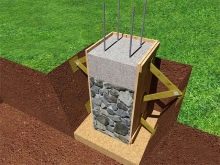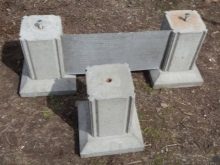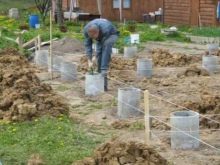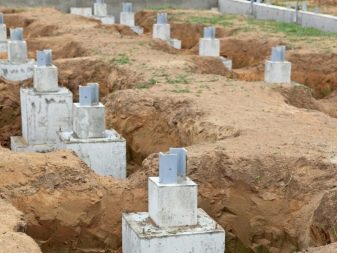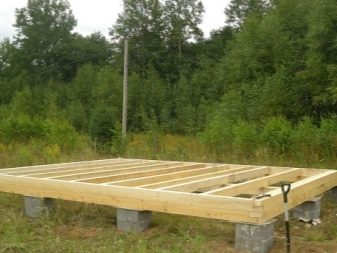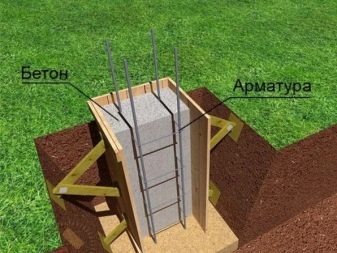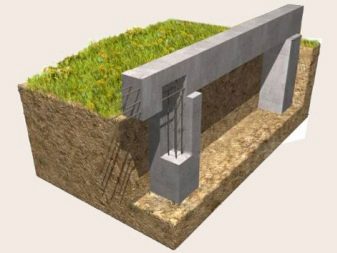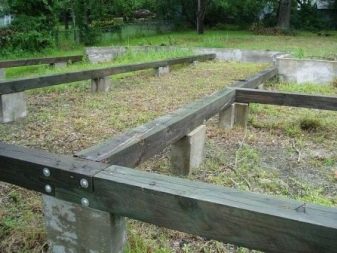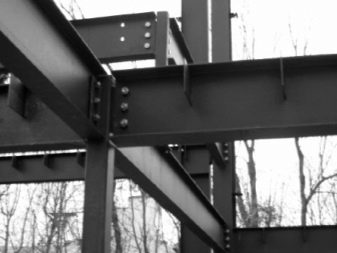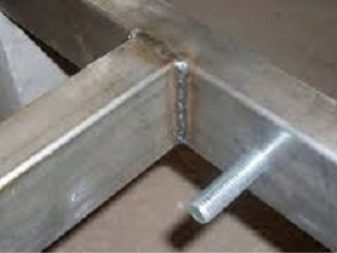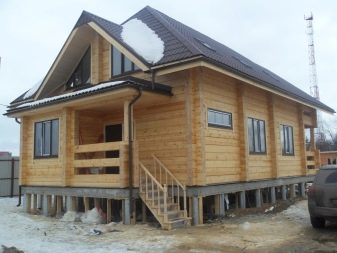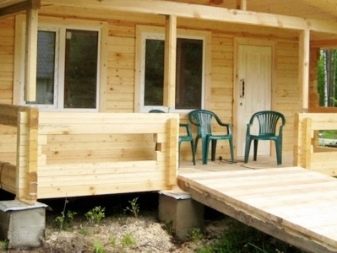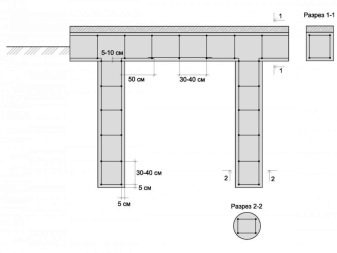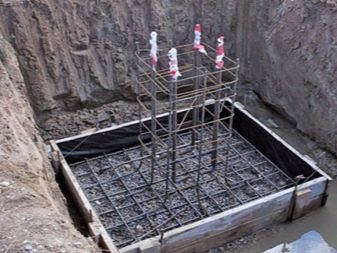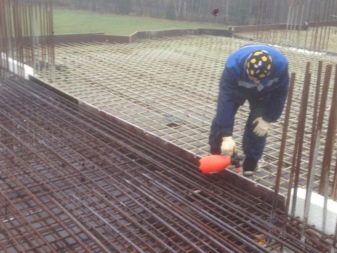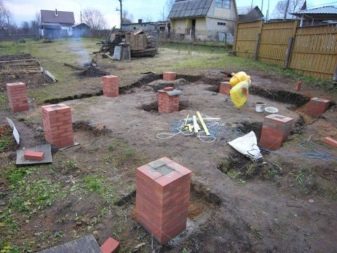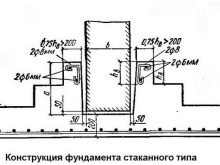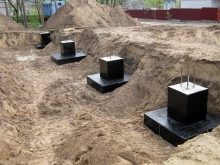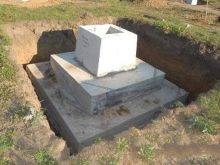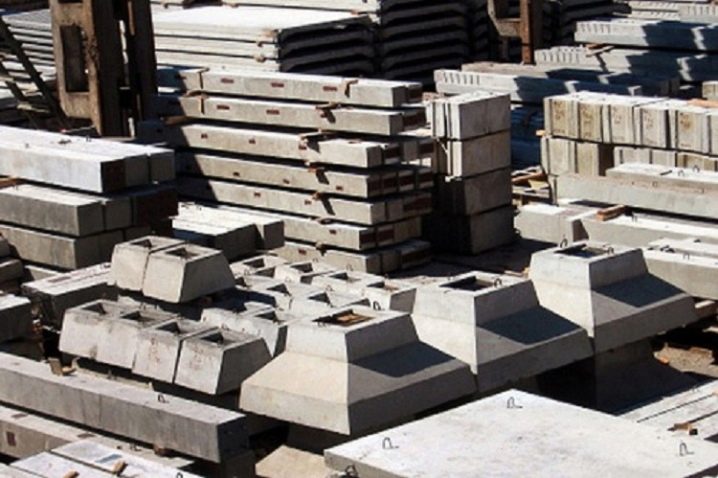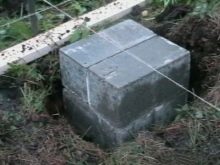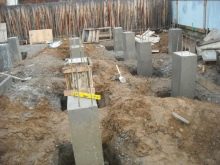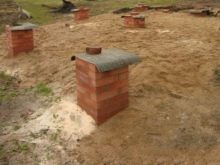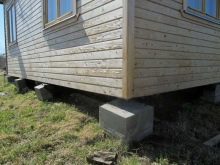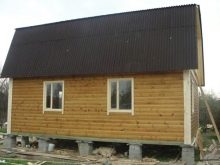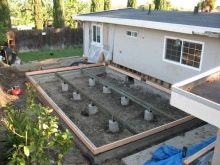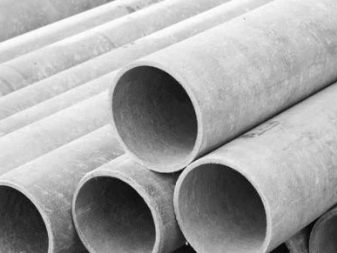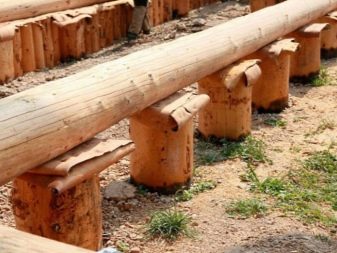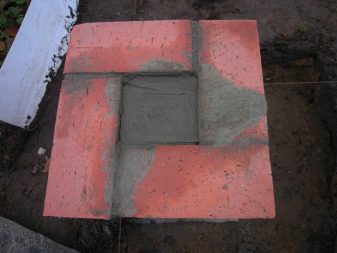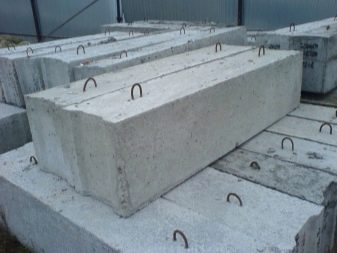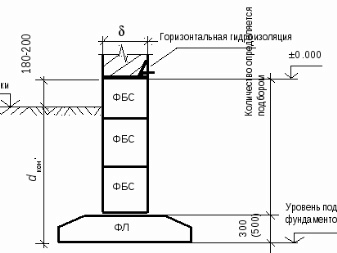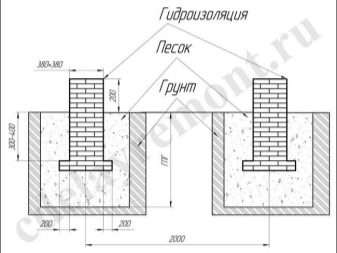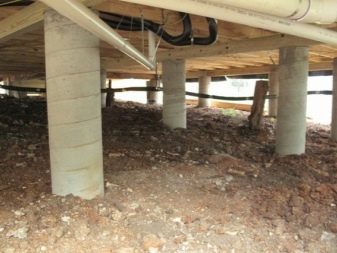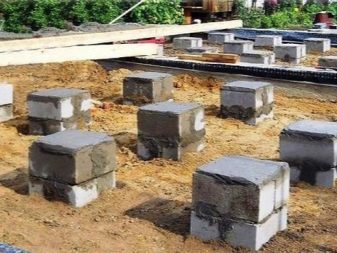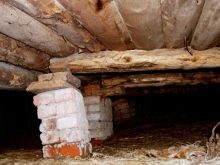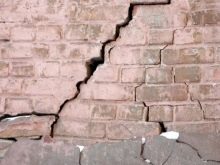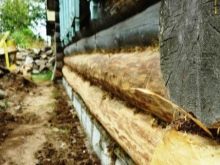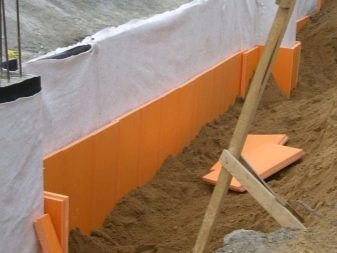Pillar foundation: the calculation and making their own hands
The beginning of construction is the construction of the supporting structure under the house. Often as its foundation serves on the pillars. Any responsible developer is obliged to know exactly how such work is done - at least for the sake of full control of the work of hired teams.
What it is?
It is intuitively clear that the column base is a set of supports standing separately from each other under the structure. It will be easier to understand what this type of foundation construction is about if you compare its characteristics with the pile type of support for a house that is closest in appearance. In both cases, instead of a monolithic base, there are separate reference points.
But the difference is still there:
- the pile can go into the soil up to 5 m, whereas the pole is not so deeply buried;
- the pillars are supported only on the sole, and the piles are still held by the side faces;
- almost always for a structure with comparable parameters, the pile section is inferior to the diameter of the pillars;
- there is a certain difference in their use.
Common features are the geometry of the section (circle or square), the selection of separate supports and (optionally) a grillage. Main applications of column supports:
- single-storey buildings of industrial and public character (requires the most massive pillars);
- frame houses;
- houses that combine frame and shield;
- timber and log buildings;
- various enclosing elements.
Features and specifications
To make the foundation on the pillars really fulfill the task, it is necessary to take care of a number of important points, including the formwork. According to official regulations, instead of shield formwork can be used a selection of pipes made of durable plastic or asbestos cement. Such a solution is often more convenient. Despite the external similarity with bored piles, it is absolutely impossible to use roofing material for formwork.
Since the output below the freezing line is not guaranteed, it is required to fill the pillars with non-metallic substances. Rolls of roofing material can not provide the required hardness and protection against water penetration. In any case, unimpeded access to the place where the pillar is expanding should be organized. Prepared trenches need to be covered with sand and rubble, footing must also be poured.
In order to expand the surface used for the support, the pole block is expanded at the expense of plates, which must necessarily have a formwork.
When polyethylene pipes are used as the formwork for the construction of the building, it is allowed to use bored technology without developing the soil. Wells are prepared, the outsole is expanded using a special tool. But nevertheless the classical structure of the column base implies the gradual preparation of the plate sole.
Hydraulic insulation done in 2 or 3 layers., complemented by sealing seams with mastic. Traditional formwork in the form of shields is considered the most practical and reliable solution.In any case, the formwork must be fixed so that it does not move sideways. The well is made 200 mm wider than the outer diameter of the pipe.
To compensate for the instability of the geometry of the pillars, at the last stage of the zero cycle produce a hard binding. Rostverk can be made above ground, trailing or with deepening. Beams should be 70-150 mm away from the ground, the exact figure is determined by the clay concentration in the soil.
Thinking through the device columnar foundation, it is very important not to forget about the recommendations contained in the GOST and SNiP. The state standard allows the construction of similar foundations with and without a grillage. The recessed variety is considered more stable and stable, since the lower parts of the supports go deeper than the ground usually freezes. Therefore, the columns will not experience pressure during frost heaving.
Shallow penetration is permissible during construction work in the middle zone of the Russian Federation.
According to official standards, it is recommended to remove the ground 0.2 m deeper than the freezing line during the construction of foundations with shallow embedding in heaving soil with clayey interlayer.
From the bottom of the recess, the space is filled with sand of a large fraction, bringing the mass to the lowest point of the pillar. Sand mass should be thoroughly tamped after wetting. The technology provides that a foundation with shallow deepening is constructed taking into account the mass of the structure and the cross section of the pillars. These indicators affect the distance between the pillars. But anyway, less than 150 and more than 300 cm should not be.
If the formwork is made from plastic pipes or from rolls of roofing material, you can save a lot. It will only be necessary to do the filling in stages, producing a parallel backfill of the formed pipe. This technique avoids the expansion of the diameter in the process. Reinforcement of round formwork should be no less careful than when using square structures or shields.
The perimeter of the reinforcing belt of the structure cannot extend beyond its contour; moreover, the metal is immersed in concrete by 15-20 mm.
Preparation of pillar foundations with grillages is made necessarily with the withdrawal of longitudinal reinforcing rods for the upper parts of the columns at 0.25 - 0.35 m. Willingness of columns does not come before 5 days (during dry and hot weather). If precipitation falls or is relatively cold outside, it is recommended to wait 20-25 days. before removing the formwork. For hardening it is recommended to use only steel rods. In the longitudinal section, they should correspond to class AIII and have a diameter of 1.2 - 1.6 cm. If the cross-section is to be strengthened, it is advisable to take a bar with a smooth outer side from 0.6 to 0.8 cm.
When creating a reinforcing belt, it is advised to use only a special steel wire. Even the most professional welding works worsen the characteristics of the metal and lower the strength bar.
When installing round pillars of reinforcement should be made of 3 longitudinal rods, the edges of which are placed across at a distance of from 0.15 to 0.2 cm. Square supports are reinforced by four rods. According to GOST standards, the area of the base plate should be larger than the area of the base of the column.
It is categorically not allowed to deepen the pile caps into the soil or perform them flush with the surface.
It is only necessary to begin the seasonal ground movement, as the whole structure, no matter how strong concrete is used, whatever the brand of reinforcing steel, will be deformed.For houses on sand, the distance between the soil and the harness should be at least 50 mm, and on rocks prone to active movements - at least 150 mm. Particular attention should be paid to such details as zabirka. It is only in the columnar foundations, and therefore the experience of building other structures does not help to make the right decision.
The reason is simple: the gap separating the supports from the floor of the first tier on the one hand, does not have isolation from the ground on the other, as if hanging in a vacuum. It creates one of the most unpleasant situations for any designer. If a recess is made, the heat loss is immediately reduced and the leakage of soil and groundwater is prevented.. The specific parameters of the retractor can be very different, but in any case its minimum height is 50 cm above the ground. Competent execution of the work allows you to create not just another heat-insulating block, but also an aesthetically elegant design.
Pretty ZSPs are widely distributed., which are formed from blocks of pre-designed size, the installation of the main parts is carried out on pre-arranged guides. The advantage of this approach is increased speed.But to a large extent it is overshadowed by a decrease in thermal properties, which necessitates the use of insulating materials.
If the fence is created from concrete with a stone, dig a trench in which sand is added. Next is poured concrete pad that serves as a support for the stone element.
Such manipulations require great skill and meticulous execution of the rules of construction. Therefore it is necessary to turn to professional bricklayers if there are no own skills of the required level. If you plan to use only concrete, it will also be impossible to do without adding sand. The fence is 0.3 m thick.. This design is created by the hands fairly quickly, but you need to be careful and attentive when working.
Thermal insulation of pole supports with a height of 0.7 m is especially scrupulous. Initially prepared frame based on the metal profile. Sheet heat insulating material is attached to the inside of the frame, outside put a profile flooring that covers the heat protection from the destructive effects. To saturate the gap from the surface of the earth to the bottom of the house, apply bulk insulation material.
The profile sheet is used around the perimeter more often than other options due to its external elegance, speed of installation and reliability of the structure.
Kinds
Even a brief acquaintance with the device of the pillar foundation shows that it can be very diverse in execution. But besides the creative delights and prescriptions of official standards, there is a generally accepted construction practice. It should also be considered when performing work, including when using plastic pipes.
The advantages of this design are:
- long period of use;
- excellent cold resistance;
- combination of lightness with strength and mechanical rigidity;
- wide range of dimensions;
- sliding of the intumescent soil on the surface (this should be theoretically).
As for the use of gray pipes, intended for the construction of domestic sewage, they can save a little, but the life in the ground will satisfy very few people. Any polymer pipes are more expensive than solutions based on roofing material.
When you plan to put a pole expanding from below, a garbage bag is attached to the right place, attached with scotch tape.. It will become a container of concrete, which forms the heel of the pillar. The reinforcement of the broadening is made in the shape of the letter L.
Anchoring studs, poured into the pole itself, will help to connect it with a pillar foundation when forming a lumber bottom trim.
The PVC formwork is made permanent, and after that expansion is only being prepared. Each pillar should be laid at the same level as the others. The horizontal is determined using a laser or hydraulic level, the rope is stretched along the marked line.
Radically different from the described support-column type of the foundation. It should be noted that it is considered suitable only for temporary or very light structures. But You can get a similar design in just 2-3 days even when doing it yourself. And start betting walls can be in 10-14 days In most cases. If the works are organized correctly and the basic technical requirements are taken into account, the costs can be reduced by 50% in comparison with the pile-screw version or shallow-depth tape. Another undoubted advantage is the conservation of heat, especially noticeable difference in buildings, where people are only occasionally.
It should be remembered that the decisive answer, whether the construction of the foundation will be reliable, can only be obtained from experience in a particular area. In this case, if there is a building with a pile-screw base in the same place, it is necessary to check the state of its supports for 3 or 4 years after the start of operation. Even the most developed and technically reinforced pillar foundations will not be able to hold heavy brick houses with asymmetry of loads. In addition, the mechanical strength of the soil layers closest to the surface is insufficient, they are invariably soaked with moisture even in relatively dry places.
In any case, the choice of pillars means the refusal to create a basement, basement or other options for the development of the basement. No matter how hard they tried to set up the pillars themselves, digging a pit that meets the technical requirements and laying out a stable box would be impossible.
To perform the support-columnar foundation, one of four schemes is used:
- the creation of pillars on the basis of rubble stone or brick;
- the use of factory-made concrete blocks of standardized size;
- casting of truncated pyramids with binding of all parts to the ground due to additional technical solutions;
- casting concrete into formwork associated with a gravel pad.
The small deepening of the pole supports makes it possible to achieve excellent protection against water, to organize full drainage and to some extent simplify the work on weatherization.
How deep the foundation pit should be is determined by the overall density and bearing force of the soil. So, on top of the fine sand or stony rock, there is enough gravel filling over an additional sand layer, the thickness of which is 100-150 mm. It is necessary to strive to ensure that the proportion of the height of the column to its cross section was minimal., it will immediately increase the stability of the building. The use of sieved gravel barriers and geological textiles helps prevent the ingress of water even on very wet or flooded soils.
The final decision on how deep and powerful the pillow should be, is made taking into account the rigidity of the lower rims, and also is guided by the strength of the potential transverse shear. The thinnest pillars formed from asbestos-cement pipes are the deepest of all. But when using ready-made reinforced concrete blocks, surface dumping meets all the requirements. If you need to choose the simplest and most technologically advanced option, supports based on red ceramic brick will be preferable.. Under them digging a pit with a depth not exceeding 250 mm, a pad is poured and a concreting of the bearing surface under the brick column is made; the surface should be 30 or 40% larger in area than the cross-section of the support.
The support-column foundation, obtained by casting, allows you to reduce costs, but it will have to exert more effort and wait longer for the result. The column is made using collapsible formwork, for which the boards or chipboard are used. The form used when pouring the column body is placed on a sandy pillow with the addition of gravel with a total thickness of 0.1-0.15 m. The pit is dug 0.6-0.7 m in size, focusing on the construction features of the building and on the actual topography of the site . Both the formwork and the reinforcement should be thoroughly aligned vertically using tensioned cords., then make pouring heavy grades of concrete.
During the procedure, the incoming mass is compacted using hand tampers.When the post support is saturated with concrete to the upper plane, threaded rods or wire reinforcement are immediately inserted. The tops of the supports fall asleep with a small layer of wet sand and overlap with a film, ensuring the appearance of cracks during curing. For 2-3 days, the outer surface of the pillar will reach the primary fortress, when it takes another 5-7 days, the formwork is removed, trim and level the bearing surface.
In the first 24 hours after dismantling the formwork should be:
apply a coating waterproofing;
use rolled material to cover the lower part of the support;
fill the gap from the concrete mass to the borders of the pit, first with claydite, and then with a combination of clay and sand.
If you want to build a light or moderately heavy house of foam concrete, frame-type construction, a reinforced concrete column foundation with a grillage is recommended. The role of this element is as follows: dispersion and translation of the loads falling on the walls to the piles through which energy is transferred to the soil.
This solution allows you to dramatically increase stability and ensure the stable operation of the box at home for many years.
Since the grillage, except for cases with in-depth execution, is not in contact with the soil, the threat of moisture damage and the occurrence of corrosion is extremely small. But it still have to take care of waterproofing. The formwork of the grillage has a removable bottom, due to which the bottom surface is flat throughout.
Precast-monolithic grillage is formed using a metal I-beam or welded-type channel bars. The assembly of such a structure is very heavy, and in the direct sense, since the beams are very massive. In addition, we have to put up with the weakening of welded joints compared with the main part of the beams. Therefore, in low-rise buildings, it is not this type that is preferable, and not a more complex structural assembly, but a monolithic format of a grillage.
If you plan to build a wooden building from above, it is recommended to use a shallow-pillar foundation.
The advantages of this choice are:
minimum costs for the organization of earthworks (including due to the lack of need for construction equipment);
simplicity of the work itself;
savings on metal bars (they are used, but relatively small quantities);
the speed of construction, even on prone to heaving soils;
Excellent soil freezing properties.
As for weaknesses, such a solution is incompatible with very loose earth, nor is it suitable for wetland.
In addition, it is necessary to appear only minor defects, as it is necessary to immediately carry out serious repairs in order to avoid further destruction of the building. To postpone the appearance of problems, reinforcement of monolithic parts of the foundation is carried out. This is the only solution available to private developers, because they cannot produce prestressed concrete or other complicated supporting structures.
As a result of the use of valves:
significant stresses are transmitted from the surface into the deeper layers;
it is provided, in the presence of a grillage, its perfect bond with the pillars;
the overall operational life of the structure increases many times over in comparison with products not equipped with fittings.
You should not try to use ready-made formulas to determine the rational parameters of the reinforcing mesh and its individual elements.Even qualified engineers will abandon this approach and use specialized software, because you need to take into account too many parameters and use higher mathematics. Anyway, before contact with concrete, reinforcement rods must be cleaned of all paints, scale and corrosion. Additionally, anti-corrosion treatment is carried out using mixtures including phosphoric acid.
But all that is said above relates mainly to pillar-like concrete structures. And on a par with them can be used the foundation construction of brick. With proper performance of work, such a foundation confidently serves 30 and even 50 years. For foundations, an exceptionally high-grade ceramic material of red tonality is selected. It is he who absorbs the least water and turns out to be a very sturdy product.
It is recommended to take into account information on the number of cycles of freezing and defrosting.
The use of bricks with at least small cracks is unacceptable. For masonry, apply a strictly solution of 1 part cement and 3 parts of sand with the introduction of hydrophobic additives.For the base sole, pre-casting with concrete and dumping is done, which helps to improve the subsequent use and strengthen the brick foundation.
Brick pillars can not be put on weakened soils with pronounced mobility horizontally and where the height has drops of 2 m.
To complete the story about the types of the column basement stands, describing the base of stakanny type. Its structure includes:
ditch with sand or gravel filling;
plate;
element for column support;
the columns themselves.
When everything is assembled, a foundation block with a wide sole appears - 15-50 m² in most cases. Column glasses are divided into prefabricated (constructed on site) and monolithic (installed in the form of a single structure). Regardless of this graduation, it is not allowed to install glasses on the ground prone to heaving and sagging.
Since all parts are prepared in the conditions of industrial production, they fully meet the established norms and standards. Installation is greatly simplified and reliability is increased. But like all serial products, this foundation is quite expensive, it can not be supplied without special equipment.
Dimensions
The dimensions of the column base of blocks 20x20x40 are calculated:
For distances between columns in the vertical and horizontal planes.
For rebar length.
To determine the amount of concrete of the foundation and grillages. When all parameters are defined, you just need to enter them into a special program and make a quick calculation.
The dimensions are determined in such a way that there is a safety margin of 20-40%. Increased stock is taken for buildings on intumescent soils.
It is recommended to immerse the foundation below the freezing line of the ground, which directly affects its size. The lower boundary of the pit under each pillar is 0.2 m lower than the bottom of the pillar itself - this is important for backfilling sand. The supports of monolithic reinforced concrete have a size of 0.3 m, and of ceramic bricks - not less than 0.38 m, laid out of stone - from 0.6 m.
Advantages and disadvantages
But before determining the size of blocks and the consumption of materials, it is important to figure out whether to choose such a foundation at all. Pillar base is relatively inexpensive, but this is not its only advantage. The building will have a small draft and will reduce the pressure on the soil by 20% or even a little more.Because the total area of construction is reduced, which reduces installation costs. With all the advantages of a pole support, it will not be possible to put it under a heavy house, and susceptibility to horizontal shears requires the use of solid grillages.
If we talk about the support-column foundation, it must be emphasized that it has the same positive and negative sides as other structures, even to a greater degree.
Under the two-story building, even with high efficiency, such a support is not put. It is also incompatible with the slightest violation of soil stability.
Using the grillage, you can increase the strength and stability of the foundation, reduce the need for earthworks, but have to pay more than when choosing a support-column diagram. Many positive and negative sides are directly dependent on the materials used.
Thus, asbestos-cement pipes are easy to transport and install, but these low-cost structures will require drilling wells in advance. Wood is the cheapest, but at the same time it serves very little, it is easily susceptible to fire, rotting, extermination by gnawing insects and rodents.The brick turns out to be more durable, it is used well, the experience of its use is well developed. At the same time, the incompatibility with the intumescent earth and the high cost of it turn out to be flaws in the brick foundations. Reinforced concrete is stronger than all other options.however, it is more expensive than them, it is very difficult to mount and requires considerable time.
Independent production
A common practice in the construction community provides that the calculation of the foundations of the pillar foundations is carried out according to the sedimentary limit state (2nd category), and the hull is calculated according to the 1st category. First, the engineering and geological parameters of the site on which the construction is being carried out are estimated, the depth of the foundation is set. Then it will be necessary to make an assessment of the size of the sole and the total mass of the structure, calculate the load and determine the resistance value.
It is necessary to check whether the terms of calculation for deformations are met, if necessary, the value of the sole is corrected. Additionally, it is checked how strongly the foundation will be pressed against the upper line of a weak soil layer.
Even before drawing up drawings and diagrams, it is required to establish what the average statistical settlement is, what the scope of work should be.
All planned works and constructions are compared with a typical case, it is concluded that it is advisable to use an individual project. Explanatory notes are necessarily attached to the drawings, showing all the nuances of future construction and justifying the decisions made. The distance from the foot of the pole to the soil water can be at least 50 cm., since violation of this rule threatens to damage the main structures. For simplicity, the estimated depth of laying the foundation is rounded.
Building
Step-by-step instructions for the construction of the pillar foundation with their own hands provides for the drilling of holes for each site supporting the construction. Instead of fixed formwork filled with concrete, brickwork or factory-made concrete structures are often used. The choice of a solution is determined in advance, at the stage of calculations. In the presence of the grillage mounted structure that provides the distribution of loads. It is formed from reinforced concrete, wood or steel parts.Next is waterproofing, for which use the profile sheet or siding.
Under the private house, whatever the grillage is not done, piles lead under the line of freezing. The marking of the area in accordance with the planned plans is done using stakes. The usual support gap is 150-250 cm. They are placed not only under the intersections of the internal walls, but also under all furnaces and capital fireplaces. There is nothing difficult in all these works.
Repairs
It is simply not enough to fill the pillars under the house - sometimes with time they weaken and turn out to be less reliable, asbestos-cement pipes lose their characteristics especially quickly. Their amplification is often carried out by converting a previously erected pillar foundation into a dotted construction with a small depth. Blocks are placed that hold the house itself, expose them in 2 or 3 lines, digging holes about 150 mm deep into the bottom, 2/3 of their height is filled with sand. From the upper blocks to the lowest point of the house, a waterproofing is made of arbitrarily taken grade of ruberoid.
When performing all operations, you need to be extremely careful to eliminate working time and other accidents.
The loss of the columnar foundation of their qualities is indicated by:
the appearance of cracks;
difficulties in using windows and doors;
rotting or corrosion in the lower fragments of the walls.
A special conversation deserves the insulation of the column foundation. If it got together with a previously built house or has been in use for a long time, it is necessary to clarify freezing data with geologists. Most professionals believe that external insulation is preferable to internal, because it protects the structural material from harmful mechanical effects and from excessive moisture.
Selecting insulation, you need to focus not only on the level of thermal conductivity, but also on the specific gravity, the tendency to soak with water.
Whether the foundation was built under a brick, wooden or other house - it is still warmed by the same technology.
Useful tips
When the column foundation is laid out of the blocks, the seams are subject to mandatory ligation. To increase strength, voids are saturated with steel rods and a solution between them. With a depth of introduction of supports up to 1 m, it is possible not to strengthen the walls of the pits.If you plan to build a relatively heavy house, the diameter of the pipes is increased, the gaps between them are reduced. Rostverk of steel beams must be treated very carefully, otherwise corrosion will destroy it.
Do-It-Yourself Column Foundation is in the next video.
